Life Insurance Beneficiary Change – Things to Consider
Life insurance is incredibly important. It provides a lot of security in case the death of the insured happens. However, let’s take a look at a few situations in which you might actually need to engage the services of a Florida life insurance attorney. If your husband in a second marriage, for instance, failed to update the beneficiaries on his actual life insurance policy in order to reflect your marriage, you might be looking at certain complications. In situations of this kind, his first wife, as well as their children, are actually the only beneficiaries which are named under the life insurance policy. Does this provide you with grounds to dispute the policy in the event of his death? Or, what if there is a last minute change of beneficiary to a caregiver, or another family member who may have convinced the insured to change the beneficiary who was not of sound mind or who was unduly influenced?

Common Reasons for Disputes Related to Life Insurance
Some of the most common life insurance disputes are those related to beneficiary changes. The situations in which you would be capable of disputing the life insurance beneficiaries under a specific policy are limited, but not impossible. If this is the case, you should most certainly consider seeking out the legal advice of a professional Florida life insurance attorney at the Law Offices of Jason Turchin as soon as possible.
So, with this in mind, life insurance beneficiary changes may be carried out in the event of significant and life-altering events such as marriage, remarriage, divorce, birth of a child or the adoption of one – these are the most commonly used reasons to change a life insurance policy. However, there is often concern for changes made while the insured is gravely ill or lacking capacity to understand the changes being made.
Other Considerations
There is another rather common situation which can lead to a dispute for the life insurance beneficiary. It is when a seriously ill person makes a change to the beneficiaries in his or her life insurance policy towards the end of his or her life. In this case, the family members who have been actually left out of the policy are likely to claim that the policy holder wasn’t in his proper and sound mind to make a decision of the kind.
A Florida life insurance attorney with the necessary experience is helpful to understand the law and your rights. Through witnesses or medical records, it may help to establish that the policyholder did not have the mental capacity to make the changes.
Free Life Insurance Beneficiary Dispute Consultation
If you have a question about a last minute beneficiary change, or any change of beneficiary question in Florida, call our Florida life insurance lawyers at the Law Offices of Jason Turchin at 800-337-7755 today.
We handle life insurance claim disputes on a contingency fee basis, which means we waive all fees and costs if no recovery so you do not have to pay us out of pocket to take your case.
